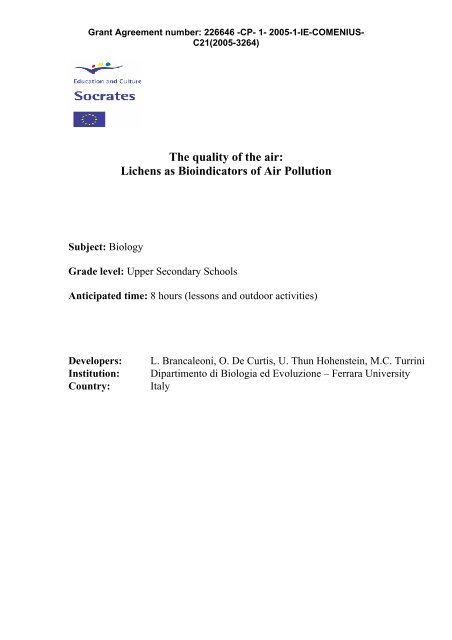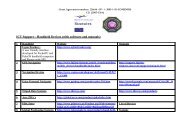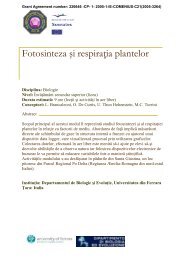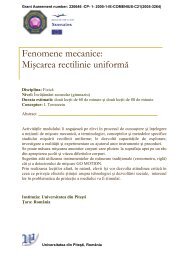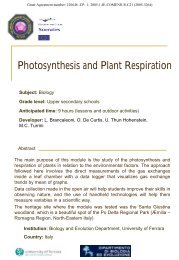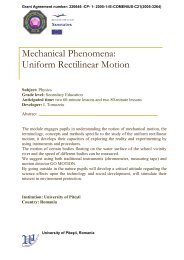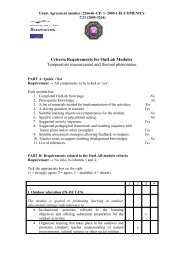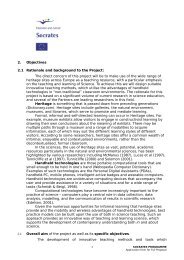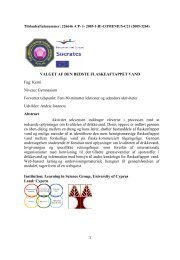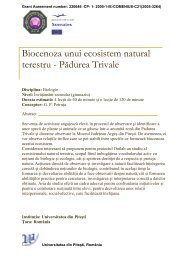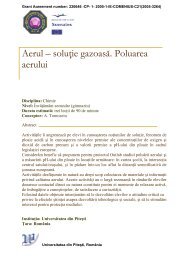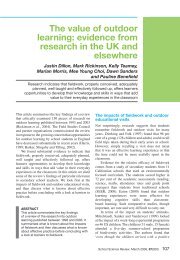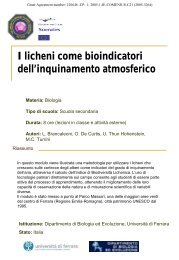Lichens as Bioindicators of Air Pollution - OutLab.ie
Lichens as Bioindicators of Air Pollution - OutLab.ie
Lichens as Bioindicators of Air Pollution - OutLab.ie
Create successful ePaper yourself
Turn your PDF publications into a flip-book with our unique Google optimized e-Paper software.
Grant Agreement number: 226646 -CP- 1- 2005-1-IE-COMENIUS-<br />
C21(2005-3264)<br />
The quality <strong>of</strong> the air:<br />
<strong>Lichens</strong> <strong>as</strong> <strong>Bioindicators</strong> <strong>of</strong> <strong>Air</strong> <strong>Pollution</strong><br />
Subject: Biology<br />
Grade level: Upper Secondary Schools<br />
Anticipated time: 8 hours (lessons and outdoor activit<strong>ie</strong>s)<br />
Developers:<br />
Institution:<br />
Country:<br />
L. Brancaleoni, O. De Curtis, U. Thun Hohenstein, M.C. Turrini<br />
Dipartimento di Biologia ed Evoluzione – Ferrara University<br />
Italy
Grant Agreement number: 226646 -CP- 1- 2005-1-IE-COMENIUS-<br />
C21(2005-3264)<br />
CENTRAL IDEA AND DRIVING QUESTION: What is the quality <strong>of</strong> the air in our<br />
town Can we use lichens <strong>as</strong> bioindicators <strong>of</strong> the quality <strong>of</strong> the air<br />
DURATION: 3 hours for the preparation in the cl<strong>as</strong>sroom (in), 2 hours for the<br />
outdoor activity (out), 3 hours for the post-f<strong>ie</strong>ld work (in).<br />
LEVEL: Upper secondary Schools<br />
PEDAGOGICAL FRAMEWORK<br />
Documentation is both a process and a product involving discovery, extension,<br />
reflection and communication (Gl<strong>as</strong>s et al., 2007). Besides, it is a tool to make<br />
learning concrete and observable (Capello, 2007). Advanced technolog<strong>ie</strong>s involved in<br />
the study <strong>of</strong> sc<strong>ie</strong>nce are a new tool <strong>of</strong> documentation (Lee, Hatherly & Ramsey, 2002;<br />
MacNaughton & Williams, 2004; Fleer et al., 2006).<br />
This module proposes the study <strong>of</strong> the quality <strong>of</strong> the air with living organisms that<br />
work <strong>as</strong> bioindicators. Therefore the botanical knowledge becomes a pr<strong>of</strong>itable tool to<br />
verify, in a simple and inexpensive way, how pure the air we breathe is. <strong>Lichens</strong> are<br />
the living organisms that can indicate the quality <strong>of</strong> the air simply counting the<br />
presence <strong>of</strong> different spec<strong>ie</strong>s in a grid area placed on a tree. Repeating the same<br />
sampling on a number <strong>of</strong> trees, will lead to the lichen biodiversity index, that is the<br />
index <strong>of</strong> air quality. Then, the sample area will be displayed on a georeferenced map<br />
and, by calculation made by the GIS s<strong>of</strong>tware, a colour scale shows the characteristic<br />
<strong>of</strong> the air and how these characteristics vary in the area.<br />
The module does not need a specific knowledge <strong>of</strong> the lichens spec<strong>ie</strong>s because it is<br />
only necessary to distinguish that one lichen is different from the other, b<strong>as</strong>ed on<br />
morphology and colour. Anyway, the module is also useful to study directly in the<br />
f<strong>ie</strong>ld the morphology and the features <strong>of</strong> the tallophytes and cormophytes.<br />
PREREQUISITE KNOWLEDGE: notions about algae, fungi and trees; notions about<br />
pollution <strong>of</strong> the air.<br />
BACKGROUND KNOWLEDGE<br />
A lichen is a symbiosis <strong>of</strong> two organisms: a fungus (the mycobiont) and an alga (or a<br />
cyanobacterium, the photobiont). The photobiont produces food for the fungus from<br />
photosynthesis and the fungus protect the alga by retaining water and providing<br />
mineral nutr<strong>ie</strong>nts.<br />
Most <strong>of</strong> the lichens take the external shape <strong>of</strong> the fungal partner: some lichens have<br />
the <strong>as</strong>pect <strong>of</strong> leaves (foliose lichens), others cover the substratum like a crust (crustose<br />
lichens) or have shrubby forms (fruticose lichens). A typical foliose lichen thallus is<br />
formed by four layers. The uppermost layer (the cortex) is formed by fungal hyphae<br />
building a protective outer layer. Beneath the cortex there is an algal layer composed<br />
<strong>of</strong> algal cells embedded in rather densely interwoven fungal hyphae. Beneath this<br />
layer there is the medulla, a third layer <strong>of</strong> loosely interwoven fungal hyphae without<br />
algal cells. The lower cortex resembles the upper surface and consists <strong>of</strong> densely<br />
packed fungal hyphae and <strong>of</strong>ten presents rootlike fungal structures known <strong>as</strong> rhizines,<br />
which attach the thallus to the substrate.<br />
Many lichens reproduce <strong>as</strong>exually with soredia, small groups <strong>of</strong> algal cells surrounded<br />
by fungal filaments (without cortex), and by isidia, extensions <strong>of</strong> the surface <strong>of</strong> the<br />
thallus for the wind dispersion. Many lichen fungi also reproduce sexually producing<br />
spores in apothecia, perithecia <strong>as</strong> normal fungi.
Grant Agreement number: 226646 -CP- 1- 2005-1-IE-COMENIUS-<br />
C21(2005-3264)<br />
Because lichens are poikilohydric organisms, without true organs, their hydratation<br />
status is related to the humidity <strong>of</strong> the air, from which depends also the mineral<br />
nutrition. For these characteristics, lichens are very sensitive to g<strong>as</strong>eous pollutants,<br />
particularly sulphur dioxide, and are widely used throughout the world <strong>as</strong> pollution<br />
indicator organisms. Lichen characters me<strong>as</strong>ured in air pollution stud<strong>ie</strong>s include<br />
observations <strong>of</strong> population changes and morphological effects because the chlorophyll<br />
is destroyed and photosynthesis is inhibited.<br />
MATERIALS<br />
- Palm handheld computer or Laptop<br />
- GPS<br />
- Folding rule or tape me<strong>as</strong>ure<br />
- Hand made grid (the grid is formed by a ser<strong>ie</strong>s <strong>of</strong> 5 squares <strong>of</strong> 10x10 cm) (see<br />
Appendix 1)<br />
- Book for the lichens identifications<br />
- Little knife and small paper bags for the collection <strong>of</strong> the lichens<br />
- Digital camera<br />
- GIS s<strong>of</strong>tware<br />
- Georeferred map<br />
CONTEXT<br />
This module can be developed in any area with trees. It is possible to choose small<br />
are<strong>as</strong> <strong>as</strong> the garden <strong>of</strong> the school, the park <strong>of</strong> the city or larger are<strong>as</strong> <strong>as</strong> the whole city,<br />
the countryside, woodland and so on. We chose one <strong>of</strong> the larger parks <strong>of</strong> the city <strong>of</strong><br />
Ferrara which is an Unesco Heritage site from 1995. It is a Renaissance town with the<br />
indelible signs <strong>of</strong> splendour <strong>of</strong> the Estense court.<br />
In the city <strong>of</strong> Ferrara there are two green are<strong>as</strong> <strong>of</strong> considerable extension and a lot <strong>of</strong><br />
private gardens, but in the outskirts there is a chemical industry that can have some<br />
negative effects on the quality <strong>of</strong> the air and therefore on the health <strong>of</strong> the lichens.<br />
INSTRUCTIONAL ACTIVITIES<br />
Lesson 1: In (Preparatory)<br />
Duration: 3 hours<br />
Goals: The students study what is a lichen and prepare the tools for the data<br />
collection in the f<strong>ie</strong>ld.<br />
- Teacher checks ide<strong>as</strong> and preconceptions that students have on how to me<strong>as</strong>ure air<br />
pollution. Then she/he illustrates the method b<strong>as</strong>ed on the presence <strong>of</strong> lichens living<br />
on the tree bark, using a video that shows this method.<br />
- Students have an introduction lesson to the use <strong>of</strong> Palm Handheld Computers and<br />
GPS.<br />
- Students get confident with the recognition <strong>of</strong> lichens b<strong>as</strong>ed on their colours and<br />
shape, using pictures and/or manuals or by an internet research.<br />
- Students prepare the grid (see appendix 1), the check-list <strong>of</strong> the lichens (see<br />
appendix 2) and the spreadsheet for the calculation <strong>of</strong> the Lichen Biodiversity Index<br />
(LBI) (see appendix 3).<br />
- The students record the information about the heritage site involved in the sampling.
Grant Agreement number: 226646 -CP- 1- 2005-1-IE-COMENIUS-<br />
C21(2005-3264)<br />
Lesson 2: Out (<strong>of</strong> cl<strong>as</strong>sroom)<br />
Duration: 2 hours<br />
Goals: The students check and record the lichen frequency <strong>of</strong> the study area in order<br />
to examine the purity <strong>of</strong> the air<br />
If the module takes place in a protected area the teacher must <strong>as</strong>k the income<br />
permission and/or the permission to pick up the samples.<br />
The students are divided in small groups so that all <strong>of</strong> them can participate in the<br />
collection <strong>of</strong> the data. Every groups is responsible for the data <strong>of</strong> one station <strong>of</strong><br />
survey.<br />
Every group checks at le<strong>as</strong>t three trees in order to calculate the LBI <strong>of</strong> the station.<br />
The chosen trees are characterised by sour bark e.g. lime (Tilia) or oak (Quercus),<br />
while trees with subneutral bark (e.g. conifers) are possibly avoided.<br />
The tree should have the followings characteristic:<br />
- circumference <strong>of</strong> 60 cm at le<strong>as</strong>t;<br />
- trunk inclination
Grant Agreement number: 226646 -CP- 1- 2005-1-IE-COMENIUS-<br />
C21(2005-3264)<br />
Goals: The students calculate and interpret the lichen biodiversity index <strong>as</strong> an indirect<br />
index <strong>of</strong> the purity <strong>of</strong> the air and visualize the result in a map by GIS technology<br />
In the cl<strong>as</strong>sroom students visualize the georeferred map, where are the sampled are<strong>as</strong>,<br />
by GIS s<strong>of</strong>tware. They load the coordinates <strong>of</strong> checked trees and calculate the LBI, if<br />
not already done in the f<strong>ie</strong>ld.<br />
GIS can identify every checked point by different colours b<strong>as</strong>ed on the LBI value, so<br />
having the chance <strong>of</strong> seeing immediately where the air is pure or not (see figure 2).<br />
After having projected on a screen the image <strong>of</strong> the map with LBI, teacher leads<br />
students in a discussion on the results obtained, having in mind the safety <strong>of</strong> living<br />
beings, and on other methods <strong>of</strong> monitoring the air quality, eventually with the help <strong>of</strong><br />
an internet research.<br />
Students can compare the data that they have collected on different trees and in<br />
different are<strong>as</strong> <strong>of</strong> the town.<br />
Students can observe lichen samples with microscopy and identify the spec<strong>ie</strong>s by the<br />
use <strong>of</strong> manuals and/or internet.<br />
POSSIBLE EXSTENSIONS<br />
Students can compare the calculated LBI with the <strong>of</strong>ficial data recorded by<br />
environmental agenc<strong>ie</strong>s.<br />
They can send their results to the local environment agency, urging some<br />
counterme<strong>as</strong>ures if they are needed.<br />
Students can repeat the same survey in different places, closer and farther from<br />
potential sources <strong>of</strong> air pollution.<br />
Students can repeat the survey in different condition <strong>of</strong> weather.<br />
Students can compare different techniques (direct and indirect) to monitor the air<br />
pollution.<br />
Objectives:<br />
At the end <strong>of</strong> the module the students will know:<br />
- how quality <strong>of</strong> the air influences living organisms;<br />
- how some living organisms can be used to study the quality <strong>of</strong> the air;<br />
- how to study the pollution <strong>of</strong> the air;<br />
- the direct influence <strong>of</strong> human activity on the environment.<br />
Students will learn how to use Palm Handheld Computers, GPS and GIS technology.<br />
ASSESSMENT<br />
In small groups, students present their findings to the cl<strong>as</strong>s in order to demonstrate:<br />
- their skills in the use <strong>of</strong> Palm handheld computers and GPS;<br />
- their skills in the use <strong>of</strong> GIS<br />
- their skills to make hypothesis to explain the results.<br />
To check the competence level <strong>of</strong> the student the teacher can:<br />
- <strong>as</strong>k for the interpretation <strong>of</strong> the maps<br />
- to repeat the experiment in the garden <strong>of</strong> the school or in their own garden<br />
- <strong>as</strong>k questions about lichens and trees identification and morphology
Grant Agreement number: 226646 -CP- 1- 2005-1-IE-COMENIUS-<br />
C21(2005-3264)<br />
- verify the ability to use the GIS s<strong>of</strong>tware with the creation <strong>of</strong> a map, or <strong>of</strong> a new<br />
attribute table.<br />
- final test<br />
BIBLIOGRAPHY<br />
A.A.V.V. 2001. Manuale ANPA: I.B.L. Indice di Biodiversità Lichenica. Manuali e<br />
Linee Guida 2/2001 ANPA – Dipartimento Stato dell’Amb<strong>ie</strong>nte, Controlli e Sistemi<br />
Informativi.<br />
Capello B. 2007. Documenting your emergent curriculum. Childcare Austral<strong>as</strong>ia 3:<br />
32-33.<br />
Fleer M., Edwards S., Hammer M., Kennedy A., Ridgway A., Robbins J. & Surman<br />
L. 2006. Early childhood learning communit<strong>ie</strong>s: Sociocultural research practice.<br />
Frenchs Forest: Pearson Education.<br />
Gl<strong>as</strong>s B., Baker K., Ellis R., Bernstone H. & Hagan B. How does an inclusive<br />
environment enhance the learning <strong>of</strong> all children New Zealand Childcare Conference<br />
Paihia, July 2007.<br />
Lee W., Hatherly A. & Ramsey K. 2002. Using ICT to document children’s learning.<br />
Early Childhood Folio (6), pp. 10-15.<br />
MacNaughton G. & Williams G. 2004. Teaching young children: Choices in theory<br />
and practice. Berkshire: Open University Press.<br />
http://digilander.libero.it/licheniinrete/informazioni/ibl.htm
Grant Agreement number: 226646 -CP- 1- 2005-1-IE-COMENIUS-<br />
C21(2005-3264)<br />
Appendix 1<br />
Sample grid<br />
Material:<br />
2 fillets <strong>of</strong> wood (or pl<strong>as</strong>tic, bamboo) 52 cm long, 1-2 cm thick, nylon string (2-2.5<br />
mm Ø), drill<br />
Procedure:<br />
Make 6 holes at 10 cm <strong>of</strong> distance on the two fillet <strong>of</strong> wood. Join the two fillets with<br />
the string at every hole, keeping 10 cm <strong>of</strong> distance between the fillets. Fix the string<br />
with a knot.<br />
You can construct also a single grid to or<strong>ie</strong>nt contemporarily at all the 4 cardinal<br />
points, simply construct in the same way 4 grids and join they with a sliding string.
Grant Agreement number: 226646 -CP- 1- 2005-1-IE-COMENIUS-<br />
C21(2005-3264)<br />
Appendix 2<br />
Tree N° Photo N°<br />
Sample area (city, street…) Coordinates Spec<strong>ie</strong><br />
Circumference<br />
LBI N LBI E LBI S LBI W<br />
Candelaria concolor<br />
Candelar<strong>ie</strong>lla reflexa<br />
Lecanora allophana<br />
Lecanora carpinea<br />
Lecanora chlarotera<br />
Lecanora hagenii<br />
Lecidella elaeochroma<br />
Micarea sp.<br />
Caloplaca pyracea<br />
Rinodina pyrina<br />
Parmelia acetabulum<br />
Parmelia caperata<br />
Parmelia elegantula<br />
Parmelia ex<strong>as</strong>peratula<br />
Parmelia subrudecta<br />
Parmelia sulcata<br />
Parmelia tiliacea<br />
Phaeophyscia orbicularis<br />
Physcia adscendes<br />
Physcia biziana<br />
Physcia clementei<br />
Physconea grisea<br />
Ramalina f<strong>as</strong>tigiata<br />
Evernia prun<strong>as</strong>tri<br />
Xanthoria par<strong>ie</strong>tina<br />
Orthotricum diaphanum<br />
Orthotricum striatum<br />
Tortula papillosa<br />
Hypnum cupressiforme var. fili.<br />
grid exposition<br />
grid high on the tree<br />
If the lichen spec<strong>ie</strong>s are not known, then a practical method h<strong>as</strong> to be used in order to<br />
distinguish different spec<strong>ie</strong>s, b<strong>as</strong>ed on their colour and/or morphology (crustose,<br />
foliose and fruticose morphology)
Grant Agreement number: 226646 -CP- 1- 2005-1-IE-COMENIUS-<br />
C21(2005-3264)<br />
Appendix 3<br />
Lichen Biodiversity Index:<br />
LBI <strong>of</strong> the sample (one tree): sum <strong>of</strong> the lichen present in the single unity <strong>of</strong> the grid<br />
for every cardinal point<br />
LBI <strong>of</strong> the station cardinal point (all the trees): sum <strong>of</strong> all the LBI sampled in the<br />
same cardinal point<br />
LBI <strong>of</strong> the station (all the trees and all the cardinal points): sum <strong>of</strong> the LBI <strong>of</strong> the<br />
cardinal points divided for the number <strong>of</strong> the sampled trees<br />
Figure 1 – Example <strong>of</strong> LBI calculation
Grant Agreement number: 226646 -CP- 1- 2005-1-IE-COMENIUS-<br />
C21(2005-3264)<br />
Figure 2 - Colours <strong>as</strong>signed to different Lichen Biodiversity Index<br />
LBI COLORS LBI NATURALITY/ALTERATION COLOR<br />
7 0 Very high alteration Dark Red<br />
6 1 ≤ LBI ≤ 15 high alteration Red<br />
5 16 ≤ LBI ≤ 30 medium alteration Orange<br />
4 31 ≤ LBI ≤ 45 Low naturality/Low alteration Yellow<br />
3 46 ≤ LBI ≤ 60 Medium naturality Green<br />
2 61 ≤ LBI ≤ 75 High naturality Dark green<br />
1 LBI > 75 Very high naturality Blue
Grant Agreement number: 226646 -CP- 1- 2005-1-IE-COMENIUS-<br />
C21(2005-3264)<br />
http://botit.botany.wisc.edu/images/332/<strong>Lichens</strong>/Foliose_lichen_130_d.html<br />
http://www.ubcbotanicalgarden.org/potd/2005/10/lichen_diversity.php
Grant Agreement number: 226646 -CP- 1- 2005-1-IE-COMENIUS-<br />
C21(2005-3264)<br />
http://www.flickr.com/photos/martinlabar/141606181/<br />
foliose and<br />
fruticose lichens<br />
l t<br />
http://www.perspective.com/nature/fungi/lichens.html


